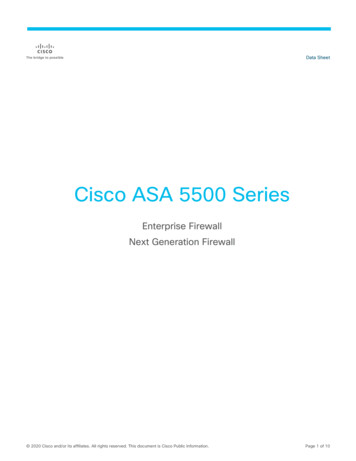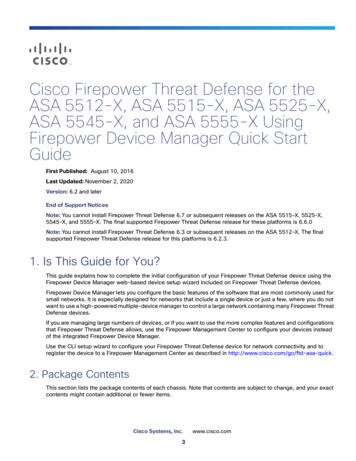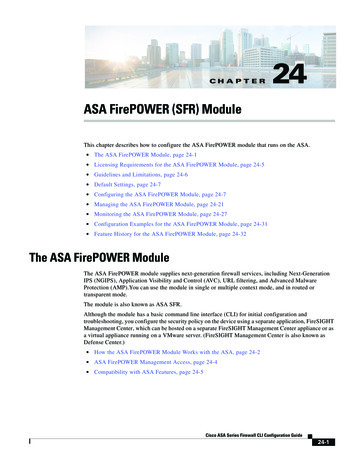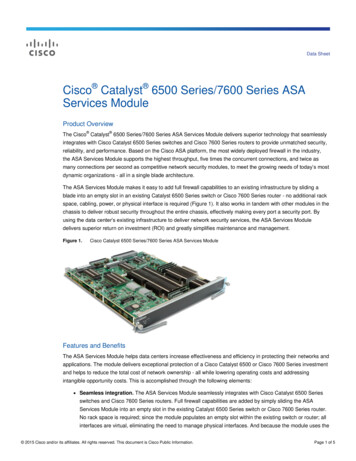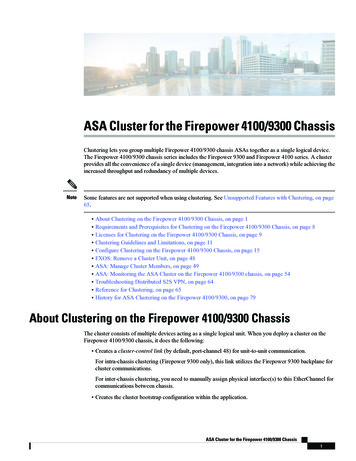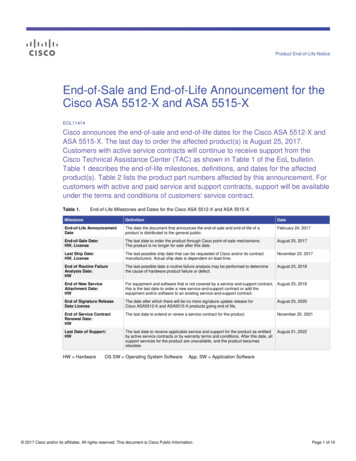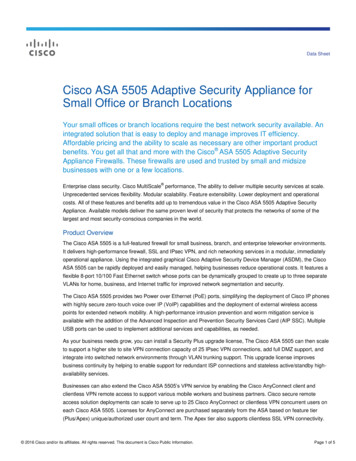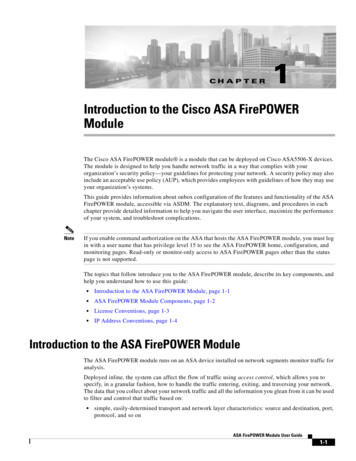
Transcription
CH A P T E R1Introduction to the Cisco ASA FirePOWERModuleThe Cisco ASA FirePOWER module is a module that can be deployed on Cisco ASA5506-X devices.The module is designed to help you handle network traffic in a way that complies with yourorganization’s security policy—your guidelines for protecting your network. A security policy may alsoinclude an acceptable use policy (AUP), which provides employees with guidelines of how they may useyour organization’s systems.This guide provides information about onbox configuration of the features and functionality of the ASAFirePOWER module, accessible via ASDM. The explanatory text, diagrams, and procedures in eachchapter provide detailed information to help you navigate the user interface, maximize the performanceof your system, and troubleshoot complications.NoteIf you enable command authorization on the ASA that hosts the ASA FirePOWER module, you must login with a user name that has privilege level 15 to see the ASA FirePOWER home, configuration, andmonitoring pages. Read-only or monitor-only access to ASA FirePOWER pages other than the statuspage is not supported.The topics that follow introduce you to the ASA FirePOWER module, describe its key components, andhelp you understand how to use this guide: Introduction to the ASA FirePOWER Module, page 1-1 ASA FirePOWER Module Components, page 1-2 License Conventions, page 1-3 IP Address Conventions, page 1-4Introduction to the ASA FirePOWER ModuleThe ASA FirePOWER module runs on an ASA device installed on network segments monitor traffic foranalysis.Deployed inline, the system can affect the flow of traffic using access control, which allows you tospecify, in a granular fashion, how to handle the traffic entering, exiting, and traversing your network.The data that you collect about your network traffic and all the information you glean from it can be usedto filter and control that traffic based on: simple, easily-determined transport and network layer characteristics: source and destination, port,protocol, and so onASA FirePOWER Module User Guide1-1
Chapter 1Introduction to the Cisco ASA FirePOWER ModuleASA FirePOWER Module Components the latest contextual information on the traffic, including characteristics such as reputation, risk,business relevance, application used, or URL visited Microsoft Active Directory LDAP users in your organizationEach type of traffic inspection and control occurs where it makes the most sense for maximum flexibilityand performance. For example, reputation-based blacklisting, because it uses simple source anddestination data, can block prohibited traffic early in the process, while detecting and blocking intrusionsand exploits is a last-line defense.ASA FirePOWER Module ComponentsThe topics that follow describe some of the key capabilities of the ASA FirePOWER module thatcontribute to your organization’s security, acceptable use policy, and traffic management strategy: Access Control, page 1-2 Intrusion Detection and Prevention, page 1-2 Advanced Malware Protection and File Control, page 1-3 Application Programming Interfaces, page 1-3Access ControlAccess control is a policy-based feature that allows you to specify, inspect, and log the traffic that cantraverse your network. An access control policy determines how the system handles traffic on yournetwork.The simplest access control policy handles all traffic using its default action. You can set this defaultaction to block or trust all traffic without further inspection, or to inspect traffic for intrusions.A more complex access control policy can blacklist traffic based on Security Intelligence data, as wellas use access control rules to exert granular control over network traffic logging and handling. Theserules can be simple or complex, matching and inspecting traffic using multiple criteria; you can controltraffic by security zone, network or geographical location, port, application, requested URL, and user.Advanced access control options include preprocessing and performance.Each access control rule also has an action, which determines whether you monitor, trust, block, or allowmatching traffic. When you allow traffic, you can specify that the system first inspect it with intrusionor file policies to block any exploits, malware, or prohibited files before they reach your assets or exityour network.Intrusion Detection and PreventionIntrusion detection and prevention is the system’s last line of defense before traffic is allowed to itsdestination. Intrusion policies are defined sets of intrusion detection and prevention configurationsinvoked by your access control policy. Using intrusion rules and other settings, these policies inspecttraffic for security violations and, in inline deployments, can block or alter malicious traffic.If the system-provided policies do not fully address the security needs of your organization, custompolicies can improve the performance of the system in your environment and can provide a focused viewof the malicious traffic and policy violations occurring on your network. By creating and tuning custompolicies you can configure, at a very granular level, how the system processes and inspects the traffic onyour network for intrusions.ASA FirePOWER Module User Guide1-2
Chapter 1Introduction to the Cisco ASA FirePOWER ModuleLicense ConventionsAdvanced Malware Protection and File ControlTo help you identify and mitigate the effects of malware, the ASA FirePOWER module’s file control andadvanced malware protection components can detect, track, capture, analyze, and optionally block thetransmission of files (including malware files and nested files inside archive files) in network traffic.File ControlFile control allows devices to detect and block your users from uploading (sending) or downloading(receiving) files of specific types over specific application protocols. You configure file control as partof your overall access control configuration; file policies associated with access control rules inspectnetwork traffic that meets rule conditions.Network-Based Advanced Malware Protection (AMP)Network-based advanced malware protection (AMP) allows the system to inspect network traffic formalware in several types of files.Regardless of whether you store a detected file, you can submit it to the Collective Security IntelligenceCloud for a simple known-disposition lookup using the file’s SHA-256 hash value. Using this contextualinformation, you can configure the system to block or allow specific files.You configure malware protection as part of your overall access control configuration; file policiesassociated with access control rules inspect network traffic that meets rule conditions.Application Programming InterfacesThere are several ways to interact with the system using application programming interfaces (APIs). Fordetailed information, you can download additional documentation from either of the following SupportSites: Sourcefire: (https://support.sourcefire.com/) Cisco: )License ConventionsThe License statement at the beginning of a section indicates the license required to use the featuredescribed in the section, as follows:ProtectionA Protection license allows devices to perform intrusion detection and prevention, file control, andSecurity Intelligence filtering. This license corresponds to the Protection (TA) subscription, whichis automatically included in the purchase of an ASA FirePOWER module.ControlA Control license allows devices to perform user and application control. A Control license requiresa Protection license. This license is included automatically when you purchase an ASA FirePOWERmodule.ASA FirePOWER Module User Guide1-3
Chapter 1Introduction to the Cisco ASA FirePOWER ModuleIP Address ConventionsURL FilteringA URL Filtering license allows devices to use regularly updated cloud-based category andreputation data to determine which traffic can traverse your network, based on the URLs requestedby monitored hosts. A URL Filtering license requires a Protection license. You can purchase thislicense as a service subscription combined with Protection (TAC or TAMC) or as an add-onsubscription (URL) for an ASA FirePOWER module where Protection (TA) is already enabled.MalwareA Malware license allows devices to perform network-based advanced malware protection (AMP),that is, to detect, capture, and block malware in files transmitted over your network. It also allowsyou to view trajectories, which track files transmitted over your network. A Malware licenserequires a Protection license. You can purchase this license as a service subscription combined withProtection (TAM or TAMC) or as an add-on subscription (AMP) for an ASA FirePOWER modulewhere Protection (TA) is already enabled.Because licensed capabilities are often additive, this documentation only provides the highest requiredlicense for each feature. For example, if a feature requires Protection and Control licenses, only Controlis listed. However, if functionality requires licenses that are not additive, the documentation lists themwith a plus ( ) character.An “or” statement in a License statement indicates that a particular license is required to use the featuredescribed in the section, but an additional license can add functionality. For example, within a file policy,some file rule actions require a Protection license while others require a Malware license. So, the Licensestatement for the documentation on file rules lists “Protection or Malware.”IP Address ConventionsYou can use IPv4 Classless Inter-Domain Routing (CIDR) notation and the similar IPv6 prefix lengthnotation to define address blocks in many places in the ASA FirePOWER module.CIDR notation uses a network IP address combined with a bit mask to define the IP addresses in thespecified block of addresses. For example, the following table lists the private IPv4 address spaces inCIDR notation.Table 1-1CIDR Notation Syntax ExamplesCIDR BlockIP Addresses in CIDR BlockSubnet MaskNumber of IP Addresses10.0.0.0/810.0.0.0 - 16.0.0 - 2.168.0.0 - 192.168.255.255255.255.0.065,536Similarly, IPv6 uses a network IP address combined with a prefix length to define the IP addresses in aspecified block. For example, 2001:db8::/32 specifies the IPv6 addresses in the 2001:db8:: network witha prefix length of 32 bits, that is, 2001:db8:: through 2001:db8:ffff:ffff:ffff:ffff:ffff:ffff.When you use CIDR or prefix length notation to specify a block of IP addresses, the ASA FirePOWERmodule uses only the portion of the network IP address specified by the mask or prefix length. Forexample, if you type 10.1.2.3/8, the ASA FirePOWER module uses 10.0.0.0/8.In other words, although Cisco recommends the standard method of using a network IP address on thebit boundary when using CIDR or prefix length notation, the ASA FirePOWER module does not requireit.ASA FirePOWER Module User Guide1-4
Chapter 1Introduction to the Cisco ASA FirePOWER ModuleIP Address ConventionsASA FirePOWER Module User Guide1-5
Chapter 1IP Address ConventionsASA FirePOWER Module User Guide1-6Introduction to the Cisco ASA FirePOWER Module
The Cisco ASA FirePOWER module is a module that can be deployed on Cisco ASA5506-X devices. The module is designed to help you handle network traffic in a way that complies with your organization's security policy—your guidelines for protecting your network. A security policy may also
